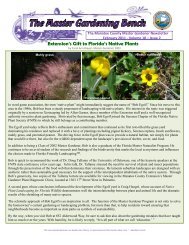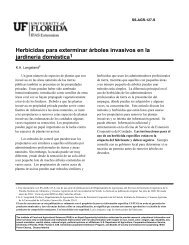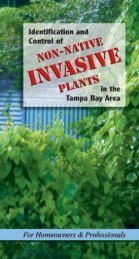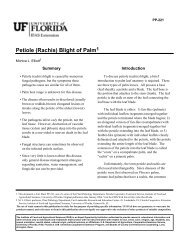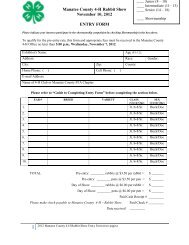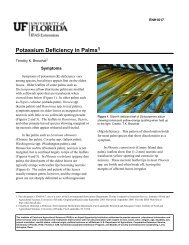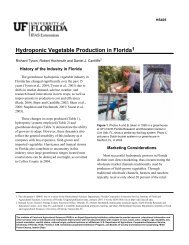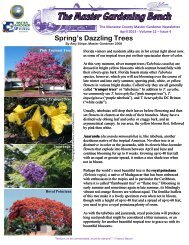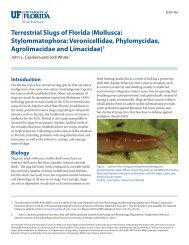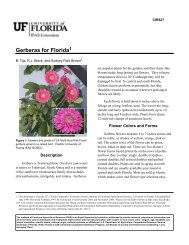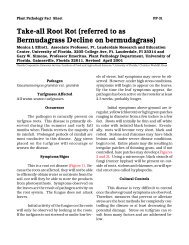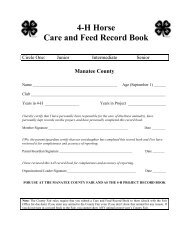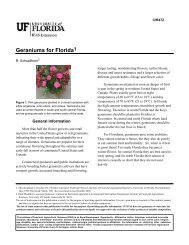Mangrove Trimming Guidelines - Manatee County Extension Office
Mangrove Trimming Guidelines - Manatee County Extension Office
Mangrove Trimming Guidelines - Manatee County Extension Office
Create successful ePaper yourself
Turn your PDF publications into a flip-book with our unique Google optimized e-Paper software.
H<br />
ealthy mangroves are more beneficial to your shoreline, to the fisheries,<br />
to our water quality, and to your landscape design than are mangroves that<br />
have been trimmed improperly.<br />
<strong>Trimming</strong> (many publications also may refer to this as “pruning”)<br />
Objective - When trimming a branch, the desired result is a nice, clean cut<br />
to the branch side of the juncture of the branch and the limb (or trunk).<br />
Damage to that junction will wound the tree. Stubs left on the tree are<br />
subject to decay, and may be a source for future insect and fungal damage.<br />
Equipment - Tools must be clean and free of oils. It is important that the<br />
tools are sharp for a clean cut. The wood at the cut should be smooth, not<br />
frayed. Frayed cuts may not heal properly and may be a source of infection.<br />
If fraying occurs, your trimmer’s tools may not be sufficiently sharp. Do not<br />
use pesticides or pruning paint on any cuts.<br />
Timing - <strong>Trimming</strong> is best done during the months of October through<br />
March, when mangroves are not growing as vigorously and energy demand<br />
for producing propagules is reduced. However, this is also the time when<br />
mangroves may be damaged or killed by freezes. It is recommended that<br />
mangroves not be trimmed for at least six months following a freeze in order<br />
to allow time to determine what portions of the tree may have actually been<br />
affected by the freeze. Removal of dead and freeze-damaged portions of a<br />
tree is a good horticultural practice after that six-month period. In addition,<br />
once mangroves have been trimmed, it is a good idea to maintain that<br />
configuration through regular (i.e. six-month to one-year intervals)<br />
maintenance trimming. This maintenance should only cut back to the<br />
previous configuration. Regular trimming will reduce stress to the tree in the<br />
future and will maintain a view of the water.<br />
Procedure - To obtain the preferred cut without the weight of the branching<br />
causing the wood to tear, follow the procedures at right.<br />
4 F LORIDA D EPARTMENT OF E NVIRONMENTAL P ROTECTION<br />
<strong>Trimming</strong> for Healthy Plants<br />
Defoliation is stressful. If all or most of the leaves are trimmed off of a<br />
mangrove, its survivability is severely reduced. Red mangroves and large black<br />
mangroves are most susceptible to death from defoliation. To prevent this from<br />
happening, it is recommended that no more than 25% of the foliage is removed<br />
annually. It is also recommended that the upper 50% of the canopy of red<br />
mangroves not be cut (i.e., no top trimming of red mangroves). The upper canopy<br />
of old, mature black mangroves also should not be removed.<br />
Refer to pruning guides available from county extension agents, the<br />
International Society of Arboriculture (http://www.floridaisa.com) and<br />
bookstores for further details.<br />
Cut out and away<br />
from the larger<br />
limb or trunk<br />
Branches less than<br />
1/2 inch.<br />
Final appearance.<br />
1st cut<br />
Branches greater than<br />
1 inch. (use three cuts)<br />
Stem after trimming<br />
2nd cut<br />
FINAL CUT



